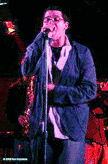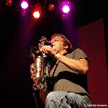|
|||||||||

There’s a funk revival goin’ on, and it hasn’t missed Annapolisby Rob Goszkowski
Lurking behind the tourist-brochure sheen and cover-band sound, there’s a secret hipness to be discovered in downtown Annapolis. Where smoke used to be, funk music hangs thickly in the air as the Higher Hands take the stage of Armadillo’s Thursday nights. Their funky weekly gig suggests a shifting music scene. “Not that I spent a lot of time in the bars when I was 15,” says keyboardist Larry Byrne, “but I don’t think a band like Higher Hands would have been successful with a year-long residency in 1998.” Byrne missed the ’90s’ bar scene, but he soaked up the decade’s Annapolis rock renaissance, when Jimmie’s Chicken Shack was at its peak and a host of other promising acts were playing locally. Now he’s part of a new thing — make that thang. There’s a funk revival goin’ on, and it hasn’t missed Annapolis. Locally, the Higher Hands tell the story. Frontman Jay Crawdads has been at center stage for years. He engages the crowd, raps, sings and plays percussion. Directly behind him is funky drummer Marty Bouchard. His octopus-armed fills are precise, and his playing hard-hitting. In jazz, funk or go-go, they give the band its strong rhythmic backbone. Bouchard has years of experience drumming on international Armed Forces Entertainment tours with Eastern Shore native Niki Barr and, subsequently, the huge 10-piece band The Groovekillers. From the band’s improvisatory jazz, Bouchard learned, he says, “how to back a soloist like I would a singer.” Matt Dalton on tenor and alto saxophone is a capable lead, playing as if he were another vocalist, sometimes using a pedal for sound effects you wouldn’t expect from a woodwind. The Frostburg music major was working as a performer and arranger for The National Ballet in Crofton when he met Bouchard. Jamming with The Groovekillers ensued. Then there’s the aforementioned Larry Byrne. Performing the tasks of two — playing bass notes with one hand and melody with the other — he makes the band sound as if five performers were on stage. “With my left hand I try to play something danceable, or I’ll lock up with the drumming,” says Byrne. “Basically I’m trying to impersonate a good bass player. “With my right hand, I play a lot of clavinet and organ,” he explains. “It’s easier than playing piano because you need busier hands to fill space on piano. On a Hammond organ, one note might have enough body and character that you can just play the one. The clavinet is very percussive, it has a wah-wah on it, so it has an electric guitar element.” Years of piano practice let Byrne make it look easy.
“I started playing piano when I was three,” he says. “My family and I went to see Return of the Jedi in the theater, and when I got home I played some of the music from it on the piano. I guess I played it well enough that my folks could recognize it. I’m sure it didn’t sound like John Williams, but they saw some potential there. I started taking piano lessons when I was four.” Getting FunkySince 2003, the Higher Hands have been making music they tag “funky-soul fusion with a twist of rhyme.” The group began as a frequent on-stage jam session featuring whoever showed up that night and a few key regulars. Landing a residency at Armadillo’s last year has solidified their roster, and the band has since become more than a side-project for these experienced players. Until late last year, all four members were part of the larger group Written Prisms. When it disbanded, they had studio time on their hands. Rather than scrap it, the Higher Hands got serious. “We didn’t have enough Higher Hands songs written when we booked studio time,” Byrne said. “We had a couple along with the ones we adapted from another project, so about half of the record we put together over the course of two months of writing.” From that crush came Grab Hold, an album of three instrumentals, four hip-hop-tinged tunes, three funky jams and one jazz cover. “The goal was to get the entire thing from start to finish with the whole band playing to get that live sound out of it and to stay true to what we actually sound like,” Byrne said. “We also want to emulate the music that we listen to a lot: ’70s’ funk recordings and fusion jazz records.” They’re not alone in that goal. Three-decades-old funk is in resurgence, never having left the minds of a younger generation who learned it through hip-hop. Hip-hop DJs and producers, especially in the genre’s formative years, relied heavily on sampling, incorporating a segment of an existing recording into a new one, to create the backing music for rap records. The most popular genres to sample were jazz and funk, James Brown in particular. Fans of hip-hop sought out the original records that their favorite artists were sampling and, in turn, became fans of funk. James Brown, whose career had stalled amidst personal problems and changing pop tastes, toured successfully again before his death on Christmas of 2006. College radio shows and club DJs are touting their rare collections of dusty unheard-for-40-years funk records. Higher Hands partners with DJs Jason Joseph and JMack to host Soulfull Parties, highlighting the beginning and current state of this trend. The band trades sets with the DJs throughout the night; the DJs spin rare-groove funk music; the band performs their original compositions of modern funk. In the past few years, the revival has hit the mainstream. Christina Aguilera’s 2006 album Back To Basics was produced with a heavy funk influence by DJ Premier, an artist who made a name for himself as a hip-hop producer sampling old funk albums. Amy Winehouse’s Back to Black record in particular has a distinctive throwback appeal, stemming from producer Mark Ronson’s use of a live band in the studio and analog recording equipment. Higher Hands see themselves as underground dwellers, but they’re encouraged by the success of these artists. “If you can be close to the edge of any genre as it grows, you’ll be closer to catching people’s ear while not sounding like a bunch of other people,” Crawford said. “Who was doin’ the Amy Winehouse thing before Winehouse? For a whole album? So now everyone knows that thing sold like a mother, and it’s really cool too, so this has gotta be the beginning.” After the band is finished recording, the next step for 2008 is shopping the album around to indie labels in hopes of support and distribution. Until they find a pretty young girl with a serious set of pipes, the band doesn’t expect to reach everyone. “Joe Schmoe? He just turns on the radio when he’s in the car,” Crawford said. “He’s going to be tough to get, and we’re trying. But there’s definitely something here for music listeners.” Yeah, agreed Byrne. “People that enjoy our band are people that like live music.” Listen to Helping Hands at HERE.Hear them live, March 20 and 27, at Armadillos in Annapolis.If you enjoyed this story check out:http://www.bayweekly.com/old-site/year05/issuexiii11/leadxiii11.html |
|||||||||
|
|||||||||
|
|
|||||||||
|
© COPYRIGHT 2008 by New Bay Enterprises, Inc. All rights reserved. |
|||||||||
 Volume 16, Issue 12 - March 20 - 26, 2008
Volume 16, Issue 12 - March 20 - 26, 2008




